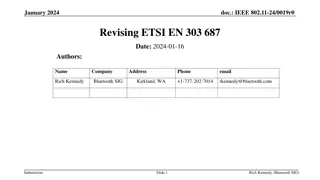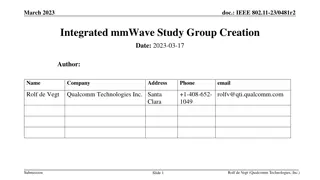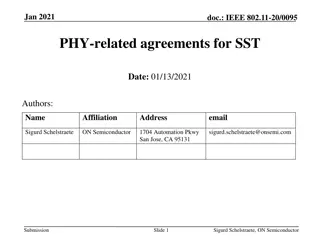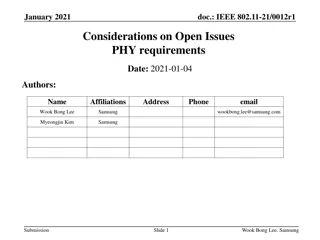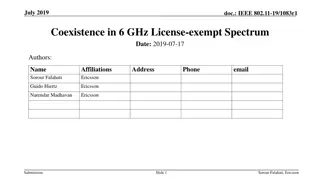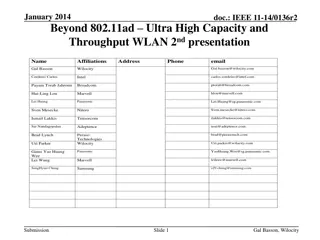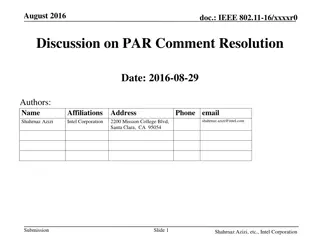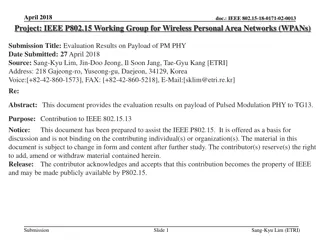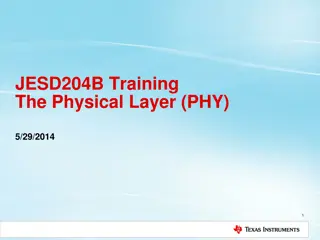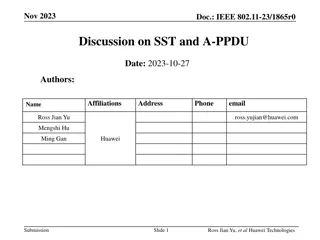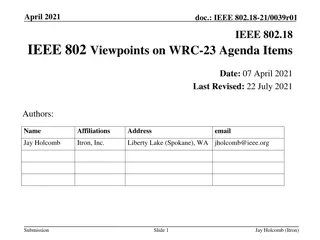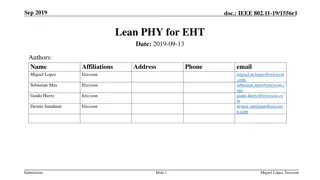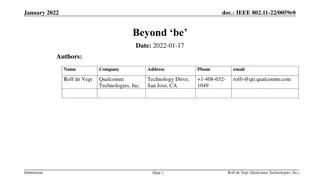Considerations on PHY for 60 GHz in IEEE 802.11-22/1865r0 Document
The document discusses the possibility of standardizing multi-link (ML) with bands in the sub-7 GHz range combined with bands in the 45-72 GHz range, proposing reusing a sub-7 GHz PHY for mmWave bands. It explores the impact of phase noise on choosing the OFDM numerology for operation in the 45-72 GHz range. Additionally, it compares the efficiency of 802.11ac and 802.11ax PHYs in terms of data rates, modulation, and coding. Lastly, it delves into phase noise compensation in OFDM systems, detailing how 3GPP supports distributed PT-RS for phase noise compensation.
Download Presentation

Please find below an Image/Link to download the presentation.
The content on the website is provided AS IS for your information and personal use only. It may not be sold, licensed, or shared on other websites without obtaining consent from the author. Download presentation by click this link. If you encounter any issues during the download, it is possible that the publisher has removed the file from their server.
E N D
Presentation Transcript
November 2022 doc.: IEEE 802.11-22/1865r0 Considerations on the PHY for 60 GHz Date: 2022-11-08 Authors: Name Miguel Lopez Affiliations Address Phone email miguel.m.lopez@ericsson.com dennis.sundman@ericsson.com Dennis Sundman Ericsson AB leif.r.wilhelmsson@ericsson.com Leif Wilhelmsson Submission Slide 1 Miguel Lopez, Ericsson
November 2022 doc.: IEEE 802.11-22/1865r0 Abstract In [1], it was suggested to standardize multi-link (ML) with bands in sub-7 GHz combined with bands in the 45-72 GHz range It was suggested to re-use one of the sub-7 GHz PHYs for the mmWave bands The phase noise (PN) in 60 GHz is larger than sub-7 GHz, so upclocking of the sub-7 GHz PHY may be needed [1, 2] 8x upclocking mentioned in [1] 4x/8x upclocking of 11ac, 16x upclocking of 11ax/be mentioned in [2] 3GPP has standardized subcarrier spacing as low as 120 kHz for FR2 (52.6-71 GHz) We discuss the impact of phase noise on the choice of the OFDM numerology for operation in the range 45-72 GHz Submission Slide 2 Miguel Lopez, Ericsson
November 2022 doc.: IEEE 802.11-22/1865r0 Recap: 802.11ac/ax PHY efficiency The .11ax PHY is considerably more efficient than the .11ac PHY Data rates (160 MHz, 1 SS) Modulation and coding 64 QAM r=2/3 64 QAM r=3/4 64 QAM r=5/6 256 QAM r=3/4 780.0 256 QAM r=5/6 866.7 802.11ac, 0.4 us GI (Mbps) 520.0 585.0 650.0 802.11ax. 0.8 us GI (Mbps) 576.5 648.5 720.6 864.7 960.7 Submission Slide 3 Miguel Lopez, Ericsson
November 2022 doc.: IEEE 802.11-22/1865r0 Recap: phase noise in OFDM systems Phase noise can cause two types of impairments to an OFDM signal 1. A common random phase rotation (CPE) (same on each subcarrier); and 2. Inter-carrier interference (ICI) between subcarriers Different sub-carrier spacings (SCS) affect the relative strengths of these two types of impairments In general, a large SCS tends to reduce the level of ICI experienced by the OFDM signal Illustration of CPE and ICI using the 802.11ad PN model (see Appendix A) BW 1280 MHz SCS (kHz) 312.5 625 1250 2500 CPE (dBc) -35.3 -32.5 -30.0 -28.0 ICI (dBc) -25.1 -25.5 -26.2 -27.4 Total (dBc) -24.7 -24.7 -24.7 -24.7 8x11ax 8x11ac Submission Slide 4
November 2022 doc.: IEEE 802.11-22/1865r0 Phase noise compensation in 3GPP 3GPP Rel 15 supports distributed PTRS (similar to 802.11 pilots) 3GPP has concluded that ICI mitigation is feasible [4] shows that a low-complexity 3- tap de-ICI filter gives significant gain (recap in Appendix B) It has been shown [4] that OFDM systems with smaller sub-carrier spacing equipped with simple ICI compensation can outperform systems with larger sub-carrier spacing equipped with only CPE compensation BLER for 480 kHz SCS in TDL-A 10 ns channel with Rel-15 PTRS structure, MCS22, BW 400 MHz, FR2 (52.6-71 GHz) [4] Submission Slide 5 Miguel Lopez, Ericsson
November 2022 doc.: IEEE 802.11-22/1865r0 Subcarrier spacing for mmWave in 3GPP 3GPP has chosen the subcarrier spacing based partially on the effectiveness of low complexity ICI mitigation 3GPP supports subcarrier spacings of 120 kHz and 480 kHz in mmWave Table 1: Rel-17 FR2-2 subcarrier spacing and supported channel bandwidth SCS (kHz) 100 MHz 400 MHz 800 MHz 1600 MHz 2000 MHz 120 Y Y 480 N/A Y 960 N/A Y N/A Y Y N/A Y Y N/A N/A Y Submission Slide 6 Miguel Lopez, Ericsson
November 2022 doc.: IEEE 802.11-22/1865r0 CPE and ICI compensation for upclocked 802.11 OFDM PHYs Low complexity CPE and ICI compensation is feasible for the IEEE 802.11 sub-7 GHz PHYs No changes to the PHYs are required The pilots are also useful for CPE and ICI compensation ICI compensation might also be beneficial for increased reliability Submission Slide 7 Miguel Lopez, Ericsson
November 2022 doc.: IEEE 802.11-22/1865r0 Observations The 802.11 ax/be PHY is significantly more efficient than the 802.11ac PHY The 11ax/be PHY is better suited for future enhancements than the 11ac PHY E.g. there might be a need to support multi-user techniques (e.g. OFDMA) in future versions of the standard, or there might be a need for larger bandwidths (e.g. upcloking 320 MHz) OFDM systems with smaller sub-carrier spacing equipped with simple ICI compensation can outperform systems with larger sub-carrier spacing equipped with only CPE compensation 3GPP has designed the OFDM numerology for mmWave taking into account ICI mitigation Effective, low complexity CPE and ICI mitigation for upclocked 802.11 OFDM PHYs can be performed based on the pilots Phase noise mitigation can be performed without the need to modify the 802.11ac/ax/be PHYs There is no need to standardize the phase noise compensation algorithms (proprietary solutions) ICI mitigation may also help improve reliability Submission Slide 8 Miguel Lopez, Ericsson
November 2022 doc.: IEEE 802.11-22/1865r0 Conclusions The 11ax/11be PHYs are more efficient and future proof than the 802.11ac PHY The current 802.11ac/ax/be OFDM PHY pilots can be used in low complexity, proprietary algorithms to compensate for the degradation due to CPE and ICI The choice of the OFDM numerology for 45/60 GHz should be made considering ICI mitigation ICI compensation may also be beneficial for increased reliability Submission Slide 9 Miguel Lopez, Ericsson
November 2022 doc.: IEEE 802.11-22/1865r0 Straw Poll If a new PHY for 45GHz/60GHz based on a sub-7 GHz PHY is standardized, do you agree that the PHY selection incorporates ICI mitigation? Note 1: The only change made to the sub 7 GHz PHYs is upclocking Note 2: CPE and ICI compensation are proprietary Note 3: This straw poll is for information only Y/N/A: Submission Slide 10 Miguel Lopez, Ericsson
November 2022 doc.: IEEE 802.11-22/1865r0 References 1. Some questions to answer in the SG, https://mentor.ieee.org/802.11/dcn/22/11-22-1595-01- 0uhr-some-questions-to-answer-in-the-sg.pptx Thoughts on High Frequency Band, https://mentor.ieee.org/802.11/dcn/22/11-22-1395-00- 0uhr-thoughts-on-high-frequency-band.pptx 11ay Evaluation Methodology, https://mentor.ieee.org/802.11/dcn/15/11-15-0866-04-00ay- 11ay-evaluation-methodology.doc On phase noise compensation for OFDM, https://www.3gpp.org/ftp/TSG_RAN/WG1_RL1/TSGR1_102-e/Docs/R1-2005922.zip 2. 3. 4. Submission Slide 11 Miguel Lopez, Ericsson
November 2022 doc.: IEEE 802.11-22/1865r0 Appendix A 802.11ad Phase noise model In 11ad/ay the following phase noise model was proposed [3]: -80 Phase Noise -90 + 2 1 ( / 1 ( / + ) ) f f f f = ( ) (0) PSD f PSD z 2 -100 p dBc/Hz -110 PSD(0) = -90 dBc/Hz Pole frequency fp = 1 MHz Zero frequency fz = 100 MHz Corresponding PSD(infinity) = -130 dBc/Hz -120 -130 -140 100 102 104 106 108 1010 Hz Submission Slide 12 Miguel Lopez, Ericsson
November 2022 doc.: IEEE 802.11-22/1865r0 Appendix B: phase noise compensation in 3GPP 3GPP has concluded that ICI mitigation is feasible. For example [4] shows that a low-complexity 3-tap de-ICI filter gives significant gains. To compute the filter taps one must solve a system of 3 equations with 3 unknowns, and then apply the filter to the received samples. This procedure is applied to every OFDM symbol. For subcarrier ?, suppose that ?? is the frequency domain received symbol, ?? is the channel, and ?? the known pilot symbol. The (2? + 1)-tap de-ICI filter can be obtained from minimizing the residue sum of squares: ??0+? ??0+? 1 ??0 ? ??1+? ??1+? 1 ??1 ? ??? 1+? ??? 1+? 1 ??? 1 ? ?? This is a least square problem with solution given by ??= ?? ??are the taps in the de-ICI filter. 3 and 5 tap filters (u=1 or 2) give excellent results. 2 ? ? ? ?+1 ??0??0 ??? 1??? 1 ???? ?2. ??? 1?? ??. Submission Slide 13 Miguel Lopez, Ericsson



